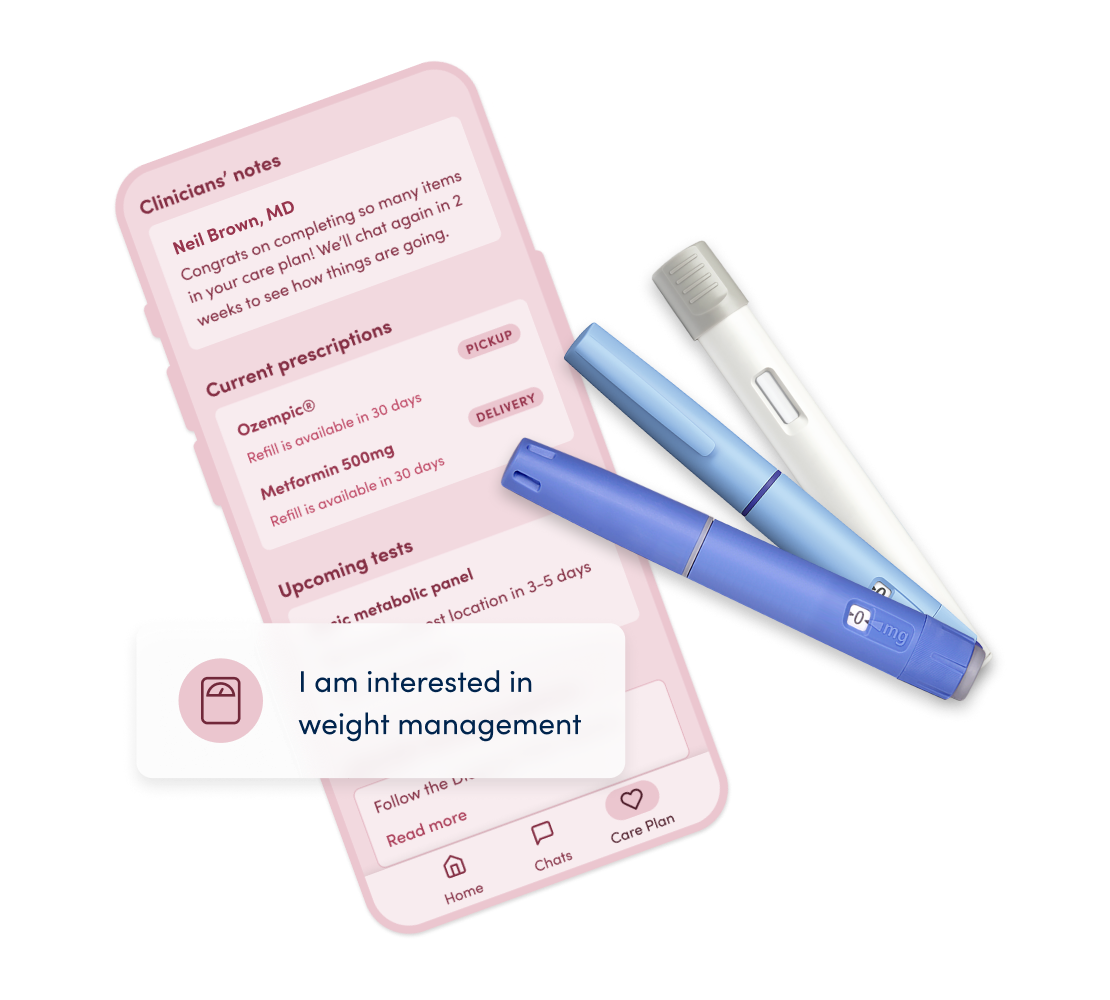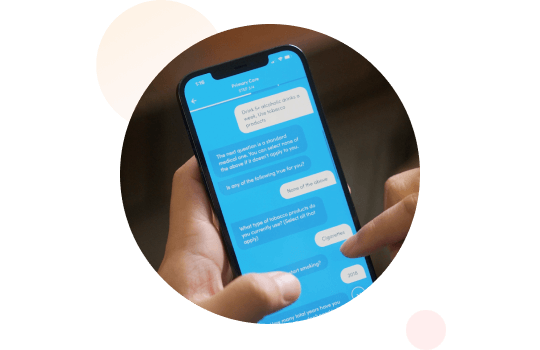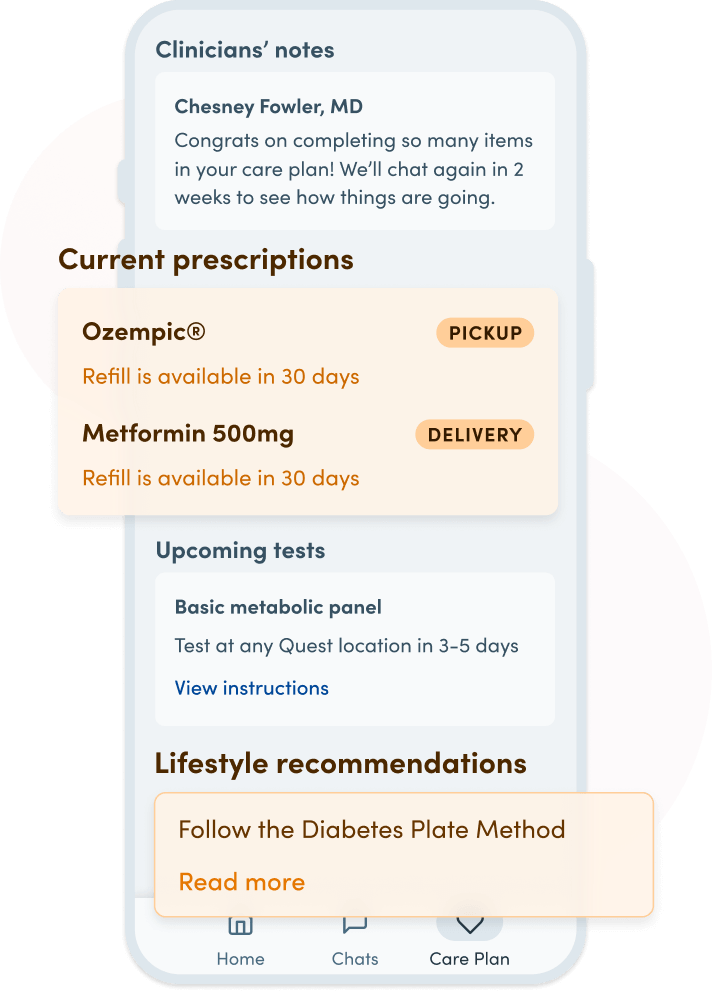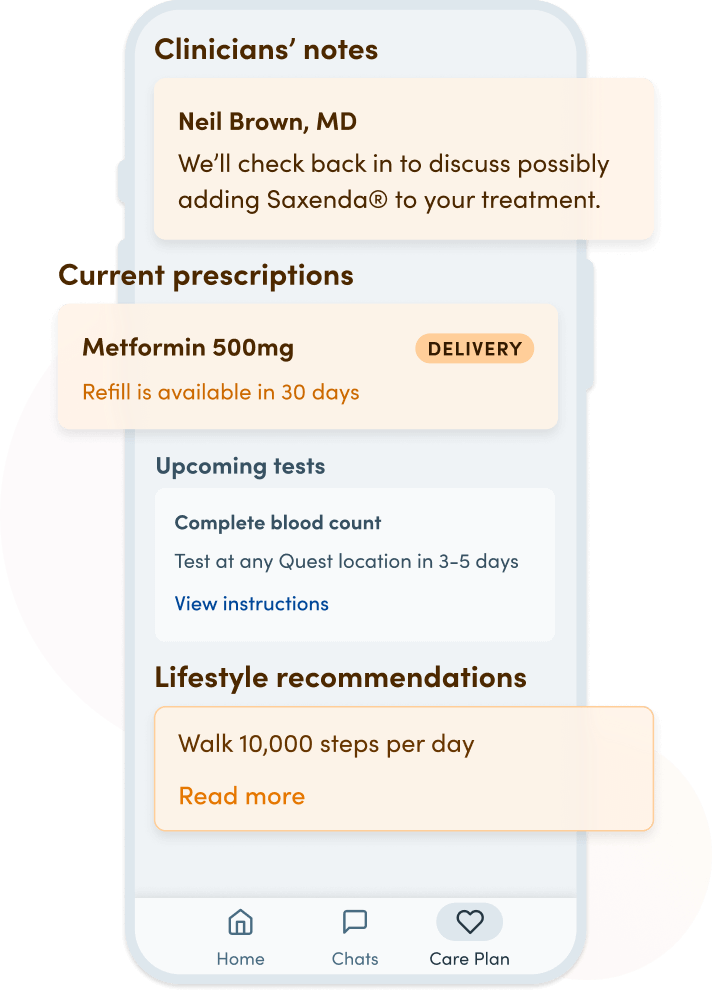Ozempic for diabetes and weight management
Take control of your whole health with the help of a licensed doctor. Because you’re more than just your weight.
At K Health, clinicians only prescribe Ozempic® to people who have type 2 diabetes. If you don’t have diabetes, another GLP-1 medication like Wegovy® or Saxenda® may be an option for you.
-

GLP-1 medication if prescribed
-

Help interacting with your insurance
-

Personalized treatment and labs

Please note: Due to high demand, there are nationwide shortages of GLP-1 medications including Saxenda. You may need to contact your local pharmacy to ask about availability.
How it works
We’re with you every step of the way

Personalized approach
Chat with your medical provider about your health goals and how we may be able to help you achieve them.

Medical weight management
Get labs done so your provider can customize a care plan for you and any chronic conditions you may have.

Focused on results
Your provider will adjust your care plan as needed to try to improve your weight, cholesterol, blood pressure, A1C, and other health markers.
Get treatment that’s right for you—we’ll help work with your insurance
Your doctor will work with you and your insurance provider to try to make your plan as affordable and sustainable as possible. That plan might look like*:
Get treatment that’s right for you—we’ll help work with your insurance
Your doctor will work with you and your insurance provider to try to make your plan as affordable and sustainable as possible. That plan might look like*:

Rick’s BMI and diabetes diagnosis mean he is more likely to get insurance approval for a GLP-1 medication.
Rick’s BMI and diabetes diagnosis mean he is more likely to get insurance approval for a GLP-1 medication.

Amber’s health insurance likely wouldn’t pay for a GLP-1 medication until she proved she had tried to manage her weight without it. After 3 months, if there were no clinical improvements, we would go back to the insurance company and ask for approval for the prescription.
Because Amber does not have type 2 diabetes, she would not be eligible for Ozempic, but could be for another GLP-1 medication.
Amber’s health insurance likely wouldn’t pay for a GLP-1 medication until she proved she had tried to manage her weight without it. After 3 months, if there were no clinical improvements, we would go back to the insurance company and ask for approval for the prescription.
Because Amber does not have type 2 diabetes, she would not be eligible for Ozempic, but could be for another GLP-1 medication.


For just $49 for your first month, you’ll also get:
Unlimited access to medical providers
Flexible appointments and anytime messaging
Easy prescription management for chronic conditions
24/7 Urgent Care for sudden medical needs
LEARN MORE
Ozempic Prescription Online

What is Ozempic?
Ozempic (semaglutide) is a prescription medication that the FDA approved for patient use in 2017. It’s in a class of drugs known as glucagon-like peptide-1 agonists, and it’s used to improve blood sugar levels in adults who have type 2 diabetes mellitus (DM).
Ozempic is typically used when other drugs, such as metformin and insulin, aren’t effectively managing a person’s type 2 diabetes. By controlling blood sugar, Ozempic may also reduce the risk of heart attack or stroke in people with type 2 diabetes and heart disease.
Currently, there is no generic alternative to Ozempic.
How does Ozempic work?
Ozempic works similarly to a hormone called glucagon-like peptide-1 (GLP-1), which naturally helps the body control blood sugar and insulin levels.
It binds to GLP-1 receptors and stimulates the pancreas to release insulin. Ozempic also reduces the amount of sugar your liver releases and prevents blood sugar increases.
It’s most effective when combined with a healthy diet and routine exercise.
Who is eligible?
Your healthcare provider can help you determine if you are a candidate for Ozempic. If you’re an adult who’s been diagnosed with type 2 diabetes mellitus, you may be eligible to take this drug. Typically, doctors prescribe Ozempic for patients who have tried medications like metformin without success.
Ozempic can be taken in addition to other medications for type 2 DM. It’s not approved for treating type 1 diabetes mellitus, or for treating patients younger than 18 years old. While Ozempic may lead to weight loss by controlling blood sugar and reducing appetite, it’s currently not approved for treating obesity.
Ozempic isn’t appropriate for people who have a personal or family history of a type of thyroid cancer called medullary thyroid carcinoma.
Is Ozempic FDA approved?
Ozempic received approval from the Food and Drug Administration (FDA) for treating type 2 diabetes mellitus in 2017. The FDA approval is based on seven clinical trials of more than 4000 patients with type 2 DM.
Is Ozempic effective?
Clinical trials have shown Ozempic to be effective in lowering a person’s hemoglobin A1c (HbA1c), a measurement of blood sugar control.
You may not notice the effects of Ozempic immediately. It may take up to eight weeks or longer for Ozempic to take full effect, because it’s a long-acting drug you only take once per week.
That said, everyone is different. If you’re concerned about your blood sugar levels after taking Ozempic for eight weeks or more, speak to your prescriber.
Ozempic is most effective at lowering blood sugar levels when combined with healthy lifestyle practices like exercise and healthy diet.
What to avoid with Ozempic
Be sure to follow your doctor’s instructions when you take Ozempic to ensure its safety and effectiveness.
While some patients take other diabetes medications with Ozempic, don’t take other kinds of semaglutide if you take Ozempic.
Never reuse a needle from an Ozempic injection. Don’t share your injection pen with anyone else (even if you changed the needle).
Ozempic is not approved for use during pregnancy. If you plan to get pregnant, tell your doctor right away so you can find another medication for controlling your diabetes. It’s best to stop taking Ozempic two months before you try to get pregnant.
Avoid drinking excessive amounts of alcohol if you take Ozempic. Alcohol can disrupt your blood sugar levels and heighten your risk of hypoglycemia, or low blood sugar.
Side effects
As with any medication, Ozempic may cause unwanted side effects. Some of the most common side effects of Ozempic are:
- Low blood sugar
- Nausea and vomiting
- Loss of appetite
- Upset stomach
- Heartburn
- Gas
- Diarrhea
- Bloating
- Headache
- Dizziness
- Fatigue
Rarely, Ozempic may cause more serious side effects. Seek immediate medical care if you take Ozempic and experience any of the following:
- Signs of an allergic reaction, such as swelling, hives, rash, or difficulty breathing
- Vision changes
- Thoughts of self-harm or suicide
- Feeling like you might pass out
- Signs of pancreatitis, such as severe pain in your upper stomach, nausea, and fast heart rate
- Signs of a thyroid tumor, such as swelling or a mass in your neck, shortness of breath, or trouble swallowing
- Signs of gallbladder problems, such as pain in your upper stomach, clay-colored bowel movements, or yellow skin and eyes
Dosages
Ozempic is a liquid medication that comes as a pen you use to self-inject in your skin once a week at any time of day.
It’s usually prescribed at .25 mg once weekly for four weeks to thirty days. After this time passes, you may take 0.5 mg once weekly for four weeks.
If this dosage properly controls your blood sugar levels, you may continue at the same dose. If not, your prescriber may recommend increasing to 1 or 2 mg once weekly.
The maximum dosage of Ozempic is 2 mg once weekly.
Always follow your doctor and pharmacist’s instructions when taking Ozempic.
Interactions
Ozempic may negatively interact with other drugs. Because Ozempic can slow down the digestive process, it may take your body longer to absorb other medicines.
Before taking Ozempic, tell your prescriber if you take any of the following medications for diabetes:
- Insulin degludec (Tresiba)
- Insulin detemir (Levemir)
- Insulin glargine (Lantus, Toujeo)
- Glimepiride (Amaryl)
- Glipizide (Glucotrol)
- Glyburide (Diabeta, Glynase Prestabs)
This is not a complete list of possible drug interactions with Ozempic. Other medications can increase the likelihood of low blood sugar when you take Ozempic or cause other unwanted side effects.
If you want to take Ozempic, your healthcare provider can help you determine whether you’d benefit from it and if any of your current medications are unsafe while taking Ozempic.
Cost
The cost of Ozempic depends on a number of factors, such as the dosage strength, insurance coverage, and your local pharmacy.
There’s currently no generic version for Ozempic, which means it may be more expensive than other drugs.
To keep drug costs low, consider shopping online for your medical treatments. A doctor can virtually prescribe your medication, and you can order it through an online pharmacy that delivers your medicine to your home.
A healthy weight leads to a healthier life
*Based on clinical studies published in Translational Behavioral Medicine, The Science of Diabetes Self-Management and Care, and the New England Journal of Medicine. Results may vary.
Frequently asked questions
How do GLP-1 receptor agonists work?
Each of the FDA-approved GLP-1 receptor agonist medications work in a slightly different way to support weight loss. Some may reduce your appetite while others may make it harder for your body to absorb fat from the foods that you eat.
It is important to note that these medications are not a replacement for exercise and a healthy diet. If you’re prescribed a weight-loss medication, clinicians will likely will recommend certain behavioral modifications, including a healthy eating and exercise program, to help you reap the most benefits from the medication, and manage or prevent any related chronic conditions.
Learn more about the side effects of Ozempic, Wegovy or Saxenda.
How do I know if weight loss medication is right for me?
Many adults with health conditions associated with their weight are eligible for weight loss medication. These conditions include type 2 diabetes and high blood pressure, among others.
To be eligible for prescription weight loss medication from clinicians practicing on the K Health platform, clinicians conduct a strict screening process, which includes ensuring a certain Body-Mass Index (BMI), the absence of certain medical conditions, and a history of unsuccessful weight loss with lifestyle modifications alone. If you don’t have a health condition associated with your weight, you must have a BMI of at least 30. If you do have a health condition associated with your weight, your BMI must be 27 or higher.
If someone isn’t a good fit for weight loss medication, they can still use K Health to manage other areas of their health, including lifestyle changes and chronic disease, mental health, and urgent care needs.
What are the side effects of GLP-1 medications?
The most common side effects of GLP-1 weight loss medications are upset stomach, nausea, bloating, constipation, diarrhea, vomiting, headache and fatigue. Typically, these symptoms are most severe in the first few weeks of taking medication and become milder or go away completely over time. Your clinician will set an appropriate dosing schedule to manage any side effects you may experience and can adjust your care plan as needed.
More serious side effects include thyroid tumors, including cancer, pancreatitis, gallbladder and kidney problems, and changes in mood. These reactions are rare, but if you experience any side effects that concern you, reach out to your clinician.
Learn more about the side effects of Ozempic, Wegovy or Saxenda.
What if my insurance won’t pay for my medication?
Your clinician and care team will work with you and your insurance provider to find the right care plan for you. Depending on your weight and other health conditions, you may be approved for a GLP-1 medication immediately, or your insurance may want to see you try other methods of weight loss first.
If that’s the case, your clinician can provide an alternate treatment as a first step and revisit your insurance authorization in a few months. In many cases, prior authorizations are approved the second time around.
Your clinician will never encourage you to take a medication that will not be affordable for you long-term by using a limited-time discount or similar method. We will work with you to ensure your care plan is affordable and sustainable.
Aren’t these medications just for diabetes? And isn’t there a shortage?
The GLP-1 medications semaglutide and liraglutide are FDA-approved for both type 2 diabetes and weight management under different brand names.
If appropriate, your clinician may prescribe you Wegovy (semaglutide) or Saxenda (liraglutide), which are both indicated for weight management, or another type of medication FDA-approved for weight management.
Your clinician may also prescribe metformin, a medication that helps to control blood sugar. While often used to treat type 2 diabetes, it can also be used to manage weight.
Because of high demand, there are currently supply shortages of Ozempic, Saxenda, and the lower doses of Wegovy. If you’re prescribed one of these medications, we recommend checking with your local pharmacy about their ability to fill your prescription. Your clinician can send your prescription to a different pharmacy if needed, or possibly provide an alternate treatment plan as a first step and revisit your GLP-1 prescription later.
Will my medical provider treat me for other health conditions I have?
Yes! Your medical provider will help you manage your whole health, including chronic conditions like diabetes, high blood pressure, high cholesterol, and more.
You’ll also be able to get 24/7 Urgent Care at no additional cost.
What if I already have a primary care doctor?
That’s totally fine. You’re welcome to use K Health for your Primary Care needs, but if you’d prefer to keep working with your current provider, you can still participate in our weight management program.
What is step therapy?
Step therapy is a type of prior authorization practiced by insurance providers. In step therapy, you begin treatment for a medical condition with the medication that’s considered “most preferred” (and is often less expensive) and progress to other therapies only if necessary.
What that means for you is that in many cases, your insurance will not cover the costs of GLP-1 medication unless you show that other methods of weight management haven’t worked for you. Your dedicated care team at K Health will help you navigate this process.
How is K Health’s Medical Weight Management Program different from other weight loss programs?
With K Health’s Medical Weight Management Program, you’ll work with a primary care physician to take care of your health holistically. They’ll help you manage most chronic health conditions and treat your weight as just one portion of your overall health.






